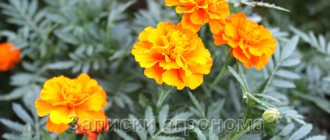Plants such as Tagetes are annual or perennial and belong to the family Compositae or Asteraceae. Their homeland is Central and South America. Local Indian tribes have long used them in their rituals, and the plants were even used for medicinal purposes. In the 16th century, the velvet drop was brought to Europe and became the first flower brought to Russia from abroad. The name was given by C. Linnaeus. He named him after the Etruscan demigod Tagues, the grandson of Jupiter, who was very handsome and had the gift of prediction. The velvet plant is commonly called blackthorn. This genus includes about 40 species, which are happily grown in different parts of the world.
Popular types and varieties of marigolds, known to every summer resident
thin-leaved marigolds or Mexican marigolds, thin-leaved Tagetes, or Mexican (Tagetes tenuifoia)
These are marigolds with the most unassuming appearance: 25-40 cm high with small (2-3 cm in diameter) single inflorescences and beautiful decorative highly dissected foliage.
But it is thin-leaved marigolds that are grown for food! Yes, you heard right, fine-leaved marigolds are actively used in flower cooking. However! They are not the only ones, read carefully our top marigolds!
Popular varieties and hybrids of fine-leaved marigolds
Marigold thin-leaved Red Gem (Gem) - height from 25 to 35 cm. Blooms with numerous reddish-brown flowers.
Tagetes thin-leaved variety Precious stone
Mexican marigolds Lemon Gem are bushes up to 35 cm high with lemon-colored flowers. Their peculiarity is small and curly reed petals, light green small leaves.
Marigold Mexican Lemon Gem
Floral cooking with marigolds
In flower cooking, the petals of fine-leaved marigolds are of particular value. They can be added to oil, vinegar or dough to give a golden color and original taste. They really like to top desserts with marigolds: it’s beautiful and you won’t accidentally poison your guests. In addition to marigolds, you can use calendula, nasturtium, roses, sage, lavender, thyme, etc. to decorate dishes.
Rejected marigolds or French marigolds, rejected Tagetes (Tagetes patula)
These are the most popular marigolds for the flower garden. A huge number of varieties of different heights, flower colors and shapes have been bred: there are varieties with a height of 15 cm to half a meter with simple, semi-double and double inflorescences with a diameter of 3 to 7 cm. The flowers can be yellow, orange-brown, orange and red.
Popular varieties and hybrids of rejected marigolds
Marigold rejected Red Cardinal (Red Cardinal) - bushes are spherical, densely branched, 40 cm high. The flowers are large, double, red-mahogany with a yellow border, 5-6 cm in diameter.
Marigold rejected Rusty Red is a small-flowered variety with double inflorescences 4-5 cm in diameter. Bushes 25-40 cm high. Flowers are dark red with a yellow border.
Marigolds rejected Red Cardinal and Rusty Red
Marigold rejected Hero - Super Hero series, early flowering varieties with compact bushes. The series has a wide palette of colors.
Marigolds rejected by Hero
Marigolds rejected Bonanza Yellow is the leader among marigolds in France, the Bonanza series of tagetes. The group is distinguished by the clean and rich colors of its large flowers. The flowers are double, up to 6 cm in diameter. The series is represented by 6 types of colors.
Marigolds rejected Bonanza Yellow
Erect marigolds, or erecta Tagetes (Tagetes erecta)
The largest of the marigolds! These are powerful bushes, 70-80 cm high with large inflorescences up to 10-12 cm in diameter! Flowers can be simple, semi-double or double, lemon, yellow or orange in color.
Popular varieties and hybrids of erect marigolds
Marigolds Beatles White Moon F1 is a beautiful hybrid of erect marigolds with a rare white color. 35 cm high, resistant to rain, wind and disease.
Marigolds Beatles White Moon F1
Marie Helen marigolds are tall marigolds with large, densely double inflorescences up to 9 cm in diameter. Flowering is early, abundant and long-lasting. Bushes up to 90 cm high. Suitable for cutting; stand in water for up to 15 days.
Is it possible to sow seeds in August before winter?
Experts do not recommend sowing marigolds in open beds in August. The best sowing time is from the end of September to the third ten days of October.
- Furrows should be made at the selected point in the bed. The soil should be soft. You can first add humus, peat or tree bark. The soil should be slightly frozen so that the seeds do not rot during the thaw.
- After sowing, the seeds should be covered with prepared soil.
- Then the bed is covered with leaves and sawdust with a layer of 10 cm. To prevent the leaves from being blown away by the wind, a net should be installed over the bed.
Rare species of marigolds that deserve the attention of summer residents
Aniseed marigold, or aniseed tagetes, Mexican tarragon (Tagetes lucida)
These marigolds are not as effective in appearance as the three previous species, however, they are valued as an aromatic and medicinal crop. The aroma of the plant resembles a mixture of tarragon and anise, for which the plant is also known under such names as Mexican tarragon, Texas tarragon, Mexican calendula .
In nature, it is a perennial herbaceous plant, with a height of 30 to 70-75 cm. The stems are erect, the inflorescences are numerous baskets about 1.3 cm in diameter, collected in flat, apical semi-umbrellas, yellow. Blooms from August until frost. Since 1798, it has been grown in Europe as an aromatic summer plant.
The most famous and aromatic cultivar, Huichol, is a traditional clone used by the Huichol Indians of Mexico.
Anise marigold, or Mexican tarragon
Small marigolds or small Tagetes (Tagetes minuta, Tagetes glandulifera)
Miniature marigolds are native to South America. In Argentina, Chile, Bolivia and Peru they were used as a seasoning, for making drinks and for medicinal purposes. In the United States, marigold seasoning can be purchased as a paste in jars, and you can also find crushed and frozen leaves for sale.
Marigolds are small
Lemon marigolds or lemon tagetes (Tagetes lemmonii)
Also known as Copper Canyon Daisy, Mountain Marigold, and Mexican Marigold
Mountain marigolds from the canyons of southern Arizona. They are decorative shrubs, in nature reaching a height of 2.4 m and blooming with single yellow flowers with a smell reminiscent of lemon and mint. The foliage is sharp.
Tagetes filifolia
These marigolds are prized for their edible foliage, which has a sweet flavor with a strong licorice and anise aroma. In cooking they can be used as a substitute for tarragon.
The bushes are spherical in shape, in the middle zone they grow up to 35-40 cm in height. The leaves are thin and tender.
Best grown in long day conditions. With short daylight hours, flowering begins, after which the plant dies.
Suitable for growing in containers with herbs and flowers. The crop is undemanding to soil and easily tolerates drought.
Marigolds
Nelson's marigolds, or Nelson's tagetes (Tagetes nelsonii)
Mexican species of marigold. An annual herbaceous plant with a height of 50 cm to 2 m. Also known as citrus scented marigold. In Mexico and Guatemala, its flowers are eaten raw.
Caring for marigolds
These plants prefer sunny places where they bloom profusely and luxuriantly. They can also be grown in partial shade to partial shade. During the active growth of the flower, water frequently and abundantly, but as soon as the inflorescences begin to form, watering should be reduced, otherwise the roots may rot due to stagnation of water, and flowering will not take place. Marigolds can be fertilized as desired and respond very positively to it. Use multi-component fertilizers. The first feeding should be carried out when the plants reach a height of ten centimeters, the second - at the beginning of budding, and the third - during flowering.
Such flowers require frequent weeding, as well as loosening the soil. If the bushes grow in summer, it will be possible to carry out formative pruning. If you remove faded inflorescences in a timely manner, the intensity of flowering will increase. The strong smell of the plant and the phytoncides it contains protect it and nearby flowers from fungal diseases. Very often, experienced gardeners plant them around the perimeter of the entire plot. If the summer is wet and rainy, slugs can cause damage. To expel these pests, it is worth placing jars of bleach between the bushes. In rare cases, gray rot may appear on leaves and shoots. Infected shrubs should be dug up and burned, as they can infect other plants. In the case of prolonged summer drought, spider mites often take root. To get rid of it, an infusion of yarrow, onion or red hot pepper is recommended. In the dry season, to prevent this, it is necessary to spray the bushes with water from a spray bottle several times a day.
Do I need to loosen sunny flowers?
It is necessary to do this, since marigolds “love to breathe.” Loosening is carried out at least once every 10 days.
In order not to damage the roots and stems, this must be done carefully, using a small stick or spatula.
This measure perfectly stimulates the flowering process. It is also important to remove dried inflorescences in a timely manner so as not to interfere with the development of new buds.
Pests
Spider mite
It shows itself even on seedlings if it is in a room with dry air. But sometimes already formed plants can be exposed to this danger in dry weather. Symptoms of damage: the leaves become whitish, and then the entire plant dies.
You can resist mites by humidifying the air. Many gardeners recommend using tobacco tincture. It is prepared as follows: pour 200 grams of tobacco with three liters of water and let it brew for two days. Then filter and dilute to 10 liters of water with the addition of 50 grams of laundry soap until it is completely dissolved. The solution is ready for use immediately. For more information on what to do if spider mites or other pests appear on marigolds, read this article.
Whitefly
This pest appears in very hot weather and sucks the juice from the leaves, and its larvae infect the leaves with fungus, which then turn black. To combat whiteflies, you need to use special preparations purchased in the store.
Slugs and snails
They go on the attack in wet weather, gnawing stems and leaves. To combat slugs, you just need to collect them from plants and sprinkle the soil in a circle with ash and lime.
You can learn more about all diseases and pests of marigolds in a separate material.
Diseases
Blackleg
Most often found in still young plants. It is characterized by light pigmentation at the bottom of the stem, which gradually darkens and rots, causing the entire plant to die.
To avoid this, you need to remember to disinfect the soil when planting seeds, but do not overdo it with potassium permanganate. If these preventive measures do not help protect the flower from this disease, it is necessary to cut off the affected areas and reduce the frequency and abundance of watering. Do this only after the top layer of soil has dried. If this does not help, and the plant continues to die, we recommend replanting it in new soil.
Root rot
As a result of unsuitable growing conditions for marigolds, they can be attacked by root rot. It manifests itself in the slow development of the plant and yellowing of the stem and leaves. To avoid this misfortune, you should take into account all the recommendations for choosing a landing site given in the article above.
Important! Do not plant flowers where flowers with this disease were found last year.
You can find out what to do if the marigolds dry out, the leaves fade and the buds turn black in a separate article.
A little history
Marigold flowers in the photo are presented in all their diversity. However, not everyone knows that this variety of ornamental plants was brought to Russia in the 16th century.
Marigolds were widely used by the Mayan tribes, but not to create beauty in their local areas, but exclusively for medicinal purposes. They were also used in ritual activities.
Sowing time
When to plant marigolds, if done through seedlings? As soon as the soil warms up enough. In different regions this does not happen at the same time. Therefore, you should be guided by the climate. In the southern regions it is the end of April, in the northern regions it is the beginning of June.
When to plant marigolds in the ground? Seeds are sown, also focusing on the weather and climate. The plant is unpretentious, the main thing is not to be hit by frost.
Breeding seedlings
You will only have to spend money on purchasing seeds in the store once, because in subsequent years you can use the seeds collected from your own dried flowers. The main thing is to store the seeds dry for a year.
But with this method of obtaining seeds, it must be taken into account that marigolds are mainly hybrids, and therefore every fourth generation of seeds will have the species characteristics of only one of its parents. In this regard, most experienced gardeners use sprouted seeds. You can get them too. To do this you need:
- Place the seeds on a plate and cover with a damp cloth.
- send the plate into a plastic bag and place it in the body.
In just three days you will receive hatched seeds.
The time for planting seeds for seedlings depends only on your desire. The sooner you want to see flowering, the earlier you plant the seeds; this can be done even in early spring. There are some nuances of sowing that should not be missed. For example:
- The composition of the soil, which should include humus, peat, turf and sand. All this must be disinfected with a disinfecting solution of fungicide or potassium permanganate.
- Don't forget about a drainage layer about 3 cm high and organic fertilizer (but not manure!).
- Make holes and place the seeds at a distance of 1.5-2 cm, then sprinkle with a small amount of soil.
- Be extremely careful when watering so as not to accidentally wash the seeds with a sharp stream of water. And make sure that the soil does not dry out.
- It is necessary to place boxes with seedlings in a place where the temperature reaches 22-25 degrees above zero.
- No later than seven days you should see sprouts, after which move the containers to a bright place, and the temperature can be slightly reduced to 15-18 degrees Celsius.
You can learn about growing marigolds from seeds here, and read how to grow seedlings yourself here.
Possible problems
Sometimes marigold bushes do not bloom or have very few flowers. Failure to bloom is often caused by overfertilization, drought or too much moisture, lack of air in dense soil, or planting in the shade. Often velvet plants direct all their energy to growing green mass, but are no longer able to bush. What can be done to stimulate flowering?
- Sunlight will make flowering abundant. But sunlight should be moderate. Morning and evening sunlight activates the flowering of inflorescences. During the hottest period, shrubs can be covered with non-woven material to provide shade.
- It is important to monitor watering. As soon as the first buds appear, reduce the amount of watering. Too much moisture can cause rot, and too much moisture can prevent flowering. It is enough to water once every 2 days with non-cold water.
- Fertilization. Perennial shrubs should be fertilized when the shoots reach a height of 10 cm. Fertilizers are applied before or after flowering. Nitrogen, phosphorus, potassium and other trace elements are added to the medium.
- Aeration. The soil should be loosened and weeded after each watering. The soil can be covered with sawdust or dry grass mulch to prevent moisture evaporation.
Erect
A group characterized by a strong stem 30-120 cm high. The central conductor clearly stands out among the rest, becoming more rustic over time. The side shoots are also oriented upward. Due to this structure of the bush, the flowers are called erect.
Large lanceolate leaves are located alternately on the bush . They are painted in different colors - from light green to dark. The inflorescence of erect marigolds is also large in size. Single flower caps have a double or semi-double shape, the diameter reaches 7-15 cm. They are predominantly monochromatic:
- white;
- yellow;
- creamy;
- orange.
After 35-40 days from the moment of blooming, it is possible to collect the ripened heads, 1 gram of which contains up to 300 seeds.
Erect marigolds can be propagated by cuttings, which form roots very quickly.
Growing sunny flowers from seeds
Seeds are sown in open ground, or an already flowering bush is placed. This is done only after the earth has warmed up thoroughly. How to plant marigolds?
Having stocked up on seeds, you need to make several grooves 5 cm deep in the soil. They are watered and the seeds are laid out. The grooves are covered with soil. Excessively dense seedlings that will appear within a month need to be thinned out.











